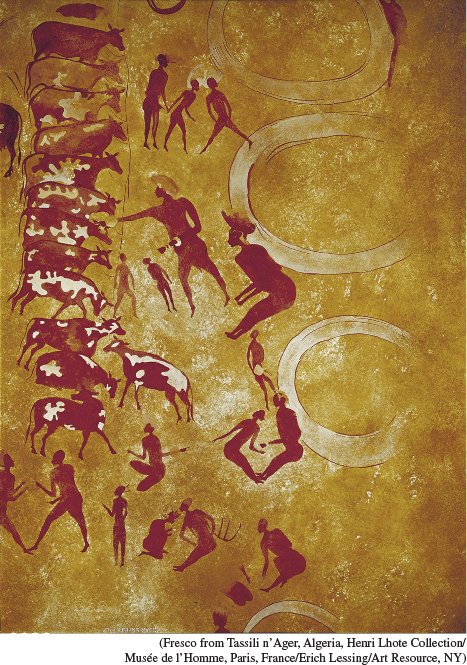Pastoral Societies
Guided Reading Question
What different kinds of societies emerged out of the Agricultural Revolution?

The Domestication of AnimalsAlthough farming often gets top billing in discussions of the Neolithic Revolution, the raising of animals was equally important, for they provided meat, pulling power, transportation (in the case of horses and camels), and manure. Animal husbandry also made possible pastoral societies, which were largely dependent on their domesticated animals. This rock art painting from the Sahara (now southeastern Algeria) dates to somewhere around 4000 B.C.E. and depicts an early pastoral community. The white ovals represent a group of huts.(Fresco from Tassili n’Ager, Algeria, Henri Lhote Collection/Musée de l’Homme, Paris, France/Erich Lessing/Art Resource, NY)
One variation of great significance grew out of the difference between the domestication of plants and the domestication of animals. Many societies made use of both, but in regions where farming was difficult or impossible — arctic tundra, certain grasslands, and deserts — some people came to depend far more extensively on their animals, such as sheep, goats, cattle, horses, camels, or reindeer. Animal husbandry was a “distinct form of food-producing economy,” relying on the products of animals.17 Those animals could turn grass or waste products into meat, fiber, hides, and milk; they were useful for transport and warfare; and they could walk to market. Known as herders, pastoralists, or nomads, peoples largely dependent on their domesticated animals emerged most prominently in Central Asia, the Arabian Peninsula, the Sahara, and parts of eastern and southern Africa. What they had in common was mobility, for they moved seasonally as they followed the changing patterns of the vegetation necessary as pasture for their animals. Some lived a nomadic existence of constant seasonal movement, but for others it was possible to combine permanent settlements in lowland areas and the movement of animals to more mountainous pasturelands in the summer.
Page 42
The particular animals central to pastoral economies differed from region to region. The domestication of horses by 4000 B.C.E. and the mastery of horseback-riding skills several thousand years later enabled the growth of pastoral peoples all across the steppes of Central Asia by the first millennium B.C.E. Although organized primarily in kinship-based clans or tribes, these nomads periodically created powerful military confederations, which played a major role in the history of Eurasia for thousands of years. In the Inner Asian, Arabian, and Saharan deserts, domesticated camels made possible the human occupation of forbidding environments. (See Zooming In: The Arabian Camel in Chapter 7.) The grasslands south of the Sahara and in parts of eastern Africa supported cattle-raising pastoralists. In the Americas, llamas and alpacas were tremendously important in the economy of Andean civilizations, but only in a few pockets in the Andes did human communities rely as heavily on their domesticated animals as did the pastoral peoples of the Afro-Eurasian world.
The relationship between nomadic herders and their farming neighbors has been one of the enduring themes of Afro-Eurasian history. Frequently, it was a relationship of conflict, as pastoral peoples, unable to produce their own agricultural products, were attracted to the wealth and sophistication of agrarian societies and sought access to their richer grazing lands as well as their food crops and manufactured products. The biblical story of the deadly rivalry between two brothers — Cain, a “tiller of the ground,” and Abel, a “keeper of sheep” — reflects this ancient conflict, which persisted well into modern times. But not all was conflict between pastoral and agricultural peoples. The more peaceful exchange of technologies, ideas, products, and people across the ecological frontier of pastoral and agricultural societies also served to enrich and to change both sides. In the chapters that follow, we will encounter pastoral societies repeatedly, particularly as they interact with neighboring agricultural and “civilized” peoples.
Page 43
AP® EXAM TIP
The AP® exam typically features questions about interactions between pastoral communities and agricultural communities and the role these interactions played in conveying culture, disease, and technology.
Within pastoral communities, the relative equality of men and women, characteristic of most Paleolithic societies, persisted, perhaps because women’s work was so essential. Women were centrally involved in milking animals, in processing that milk, and in producing textiles such as felt, which was widely used in Central Asia for tents, beds, rugs, and clothing. Among the Saka pastoralists in what is now Azerbaijan, women rode horses and participated in battles along with men. A number of archeological sites around the Black Sea have revealed high-status women buried with armor, swords, daggers, and arrows. In the Xinjiang region of western China, still other women were buried with the apparatus of healers and shamans, strongly suggesting an important female role in religious life.
